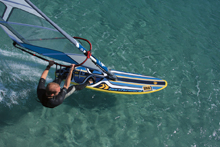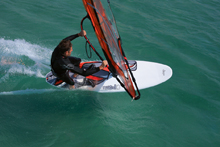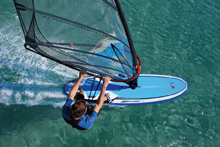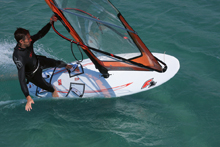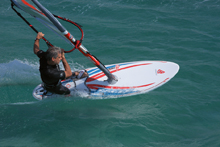The Xantos stands apart from the rest of the fleet. For starters it costs just £569, which is very little money for a composite windsurf board these days. In keeping with its budget pricing is its targeted appeal to intermediate sailors. It is designed to make life easy and fun for progressing windsurfers rather than exciting for experts, or as F2 put it, “It combines ease of use with performance and comfort”. The one very clear consequence of its budget price is a weight that is very noticeably more than its rivals. It weighs 11.26kg which is about 2kg more than the next heaviest 120. However, this is actually most noticeable off the water when carrying it around or loading it on the car and has surprisingly little impact on its intended in-water use. The 124 is the smallest of four models and best suited to lightweight early intermediates (50-65kg) or light to average weight mid-intermediates (60-75kg).
Type: Budget conscious intermediate freeride.
On the water: With its very long overall length and long planing flat the Xantos is extremely easy to get planing and to keep tracking once going. The extra length also makes it perhaps the easiest board to sail and hold upwind when off the plane, a feature that will make it very popular with intermediates, particularly inland. Despite the extra weight the 126 gets planing in as little wind as just about any other board on test. It does however have a very linear progression of acceleration, building speed gradually rather suddenly leaping forward onto the plane, and again this will endear it to the intermediate. The board will easily carry up to 8.0m and should be fine down to 5.5m. Although experts will notice the extra length in the swell and the slightly less lively feel it is nevertheless fun and easy to sail, handling chop and swell very well indeed and proving involving and exciting. Gybing performance is very commendable for all ability levels, as it enters the turn easily and holds a very predictable line, feeling both quite manoeuvrable and yet secure at the same time, and can be gybed hard and fast without skipping or stalling.
Fittings: There are no frills with basic graphics and relatively thin pads but the straps are high quality F2 gear, the fin is very well suited to the board and the deck shape and strap options are well considered and relevant.
Overall: The Xantos is not just a cheap board that is OK for intermediates – it is actually a very well designed shape specifically targeting intermediates and offering them concrete benefits that other boards don’t, such as excellent tracking, easy non-planing, excellent passive planing with measured acceleration and secure carving. Inevitably, the extra length and weight slightly compromises manoeuvrability and sparkle for advanced burn-&-turn sailors, although it says a lot that our relatively advanced guest testers all liked it despite its extra weight and intermediate targeting. It does extremely well to be so competitive for early planing, speed and manoeuvrability and still give the full shortboard experience. The Xantos is a very impressive board that we can whole-heartedly recommend to intermediates, from those starting to wrestle with straps and harness right up to those trying to sort out planing carve gybes.

